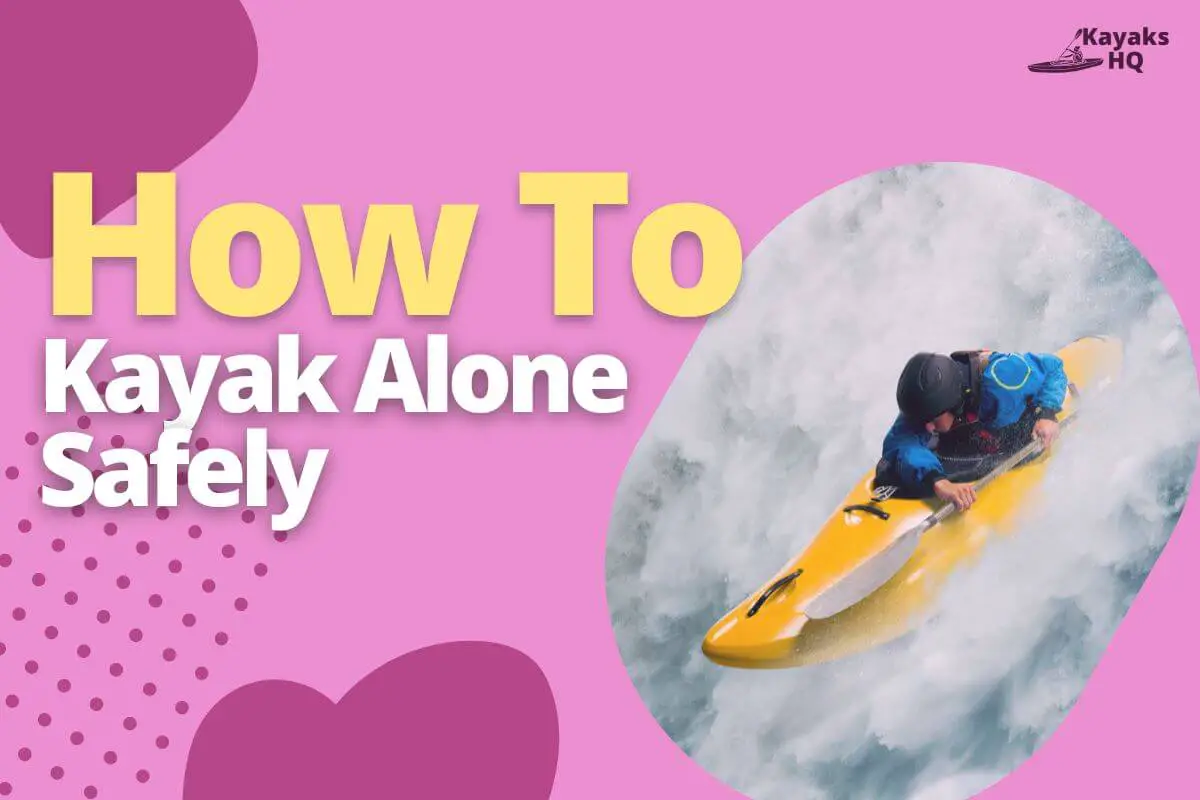Kayaking is a great sport. It’s fun and also good for you. It’s also popular, which means that you might run into other kayakers from time to time.
Kayaking alone can be dangerous. It’s easier to deal with other kayakers, but what happens if you run into something you’re not prepared for?
If you’re new to kayaking, then I’d like to give you some tips on how to stay safe when you’re kayaking alone.
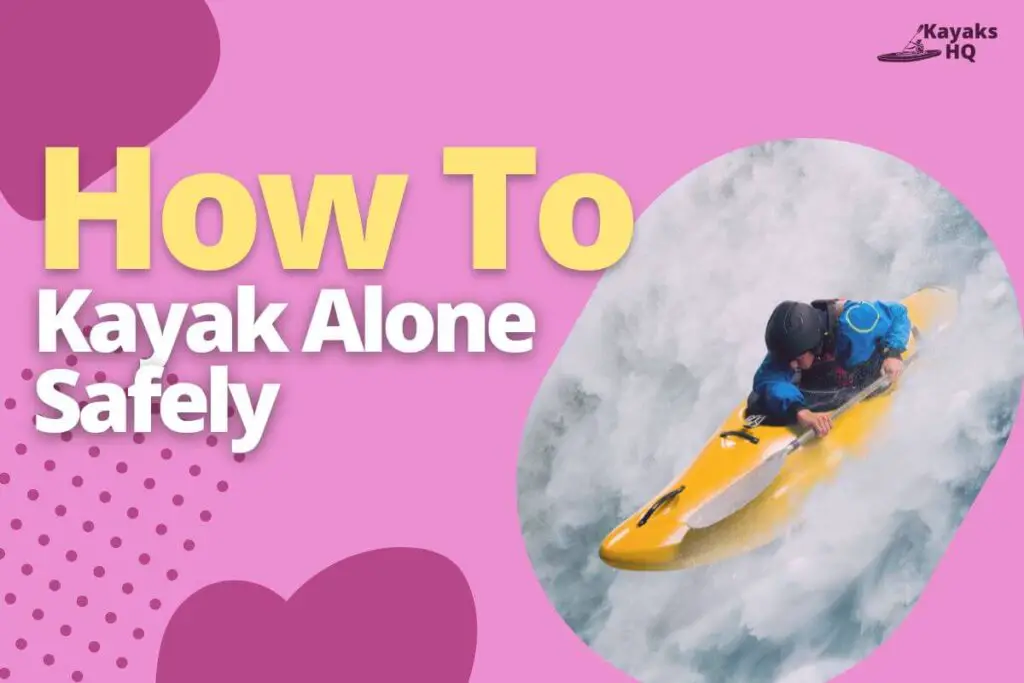
Here’s The Answer To How To Kayak Alone
When kayaking alone, it’s important to follow safety tips and stay safe. Always have a radio beacon that can transmit your location handy, and always wear a life jacket (EPIRB).
Find an experienced kayaker or canoeist to teach you the basics of kayaking before setting out on your own. Also, stay close to shore and familiar landmarks, and be aware of your surroundings.
Try to stay within shouting distance of other boats in case you need help. Also, make sure to have a working cell phone with you.
Knowing how dangerous solo kayaking can be, this article will give you some important safety precautions to take when going out alone on open water:
Make sure you know the risks
Before you set off on your own, it’s important to know the risks associated with kayaking alone. For instance:
- You need to be able to swim! If something goes wrong, this is vital. Not only will it help you get back onto dry land, but it will also keep your head above water if anything else happens.
- Know how to read a map and understand where you are going before setting off. If you are not familiar with the area or haven’t been there before, take someone who does know with you who can show you where things are and guide them through any tricky parts of their route so that they don’t get lost along the way (which could be dangerous).
- Always keep an eye on weather conditions – especially if they change quickly during hot days when thunderstorms tend to occur more often than usual, as well as know how fast currents move in different areas so that kayaks don’t get swept away by waves or strong winds pushing them towards rocks etcetera.
Beware of rips and currents
Rips and currents are powerful movements in the water that can cause you to be pulled under. Rips are strong currents that occur along a beach when waves break.
They can also be found at river mouths where the current flows out to sea or in bays with narrow entrances. Currents are caused by wind, tides, or storms, so they’re more likely to occur in open water areas than rips along beaches.
Rip currents can reach up to 2-3 feet per second, while other types of current may only reach 1-2 feet per second (0.5 m/s). To stay safe from rip currents:
- Stay calm; don’t panic if you get caught in one, and know that it’s possible for even strong swimmers to get dragged down by these powerful forces if they try to fight against them
- Before attempting any alternative means of egress, you must first swim parallel to shore until you are safely outside the flow area.
- If someone else gets caught in one of these deadly vortexes, help them get out by giving them support with your legs on either side of their body so both arms are free for swimming.
Choose a safe location to kayak
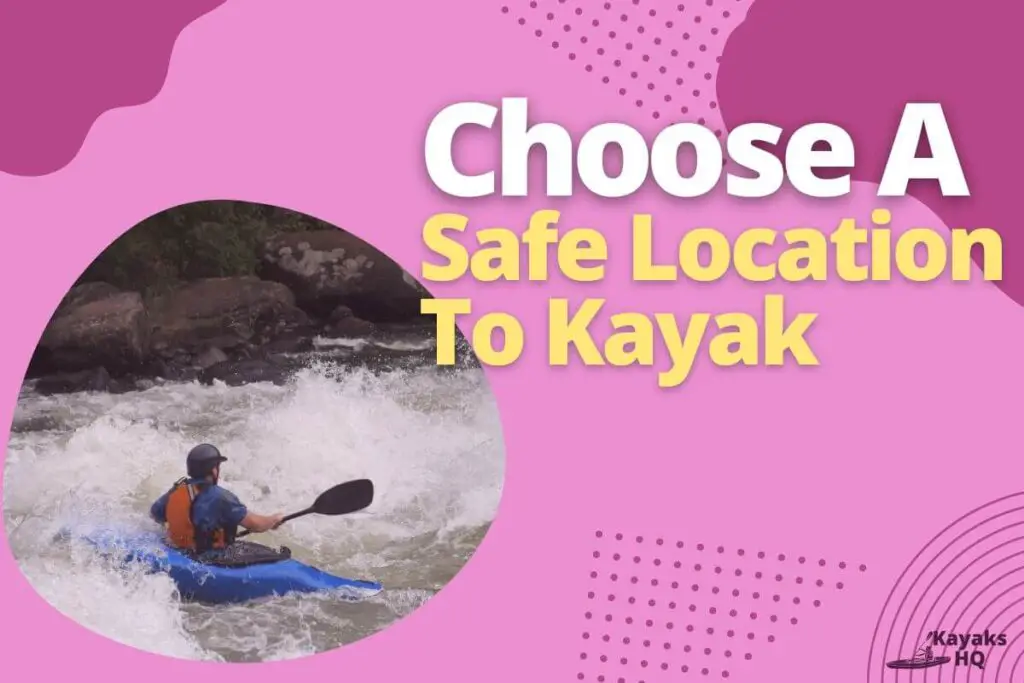
Picking a secure place is the first order of business. The most common danger for kayakers is running into rocks and other obstacles, so choose a place that is free of those kinds of things.
You also want to make sure the water isn’t rough or filled with strong currents or swells. If there are large waves in the area, it may be best to avoid them as well.
Lastly, if there are any pieces of debris floating nearby, they could easily damage your kayak if they hit it while you’re out on the water (this can’t be said enough: always wear a life jacket).
Don’t be afraid to call for help
If you need assistance, don’t be reluctant to ask for it. During your solo adventure, there are many situations in which calling for help is the best action you can take.
- In the event that you become disoriented and unable to find your way, or if you sustain an injury that necessitates rapid medical attention, it is important to seek assistance.
- If your boat capsized and has drifted away from shore or is caught on a rock in shallow water, don’t try to swim out after it—call 911 instead!
- If at any point during your kayaking trip things seem unsafe or uncomfortable, call someone who can assist with whatever situation has arisen so they can get involved before anything becomes more complicated than it needs to be.
Remember: calling for help is not a sign of weakness. It shows that a person knows their limitations and knows when they need outside assistance from another human being (or even just a 911 operator).
Kayak in a group when possible
- Safety in numbers. When you’re on the water alone, there’s no one else to watch for obstacles or help if something goes wrong. Kayaking with a group can give you more eyes on the water and increase your chances of spotting danger early and getting out of harm’s way.
- More hands to paddle. The more people you have on board, the less work each person has to do to keep moving forward—and all those extra hands will come in handy when paddling through choppy waters or against strong winds or currents.
- More hands are doing other jobs too. If someone gets tired easily (or just wants an excuse to not paddle), they’ll be relieved that there are other pairs of arms available for rowing duties while they relax or nap peacefully in their kayaks!
Important Safety Precautions To Take When Kayaking Alone
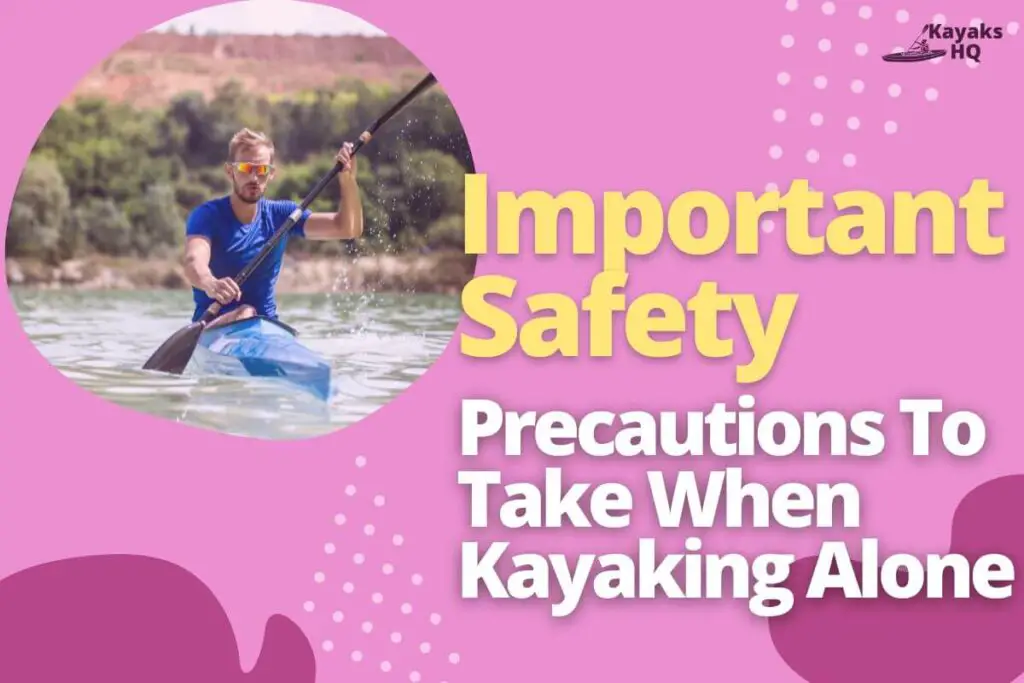
When kayaking alone, it is important to take safety precautions to ensure that you will stay safe. The following is a list of items you should carry at all times:
- Food and water: You should always make sure to bring enough food and water with you on your trip. It may be wise to pack some extra food in case something happens like a storm or bad weather.
- Emergency plan: If something does go wrong, having an emergency plan can help save lives. Your emergency plan should include how to get help, what information needs to be given for rescue purposes (e.g., location), who else knows where the kayak will be located if not found immediately after contacting authorities (family members), etc.
Always be vigilant
- While it’s important to know where you are going, it’s equally important to know what is happening in your surroundings. You must check the weather and conditions before embarking on a solo kayak trip. Check the wind direction and tides, as well as any potential hazards such as reefs or shallow water. All of which may change from hour to hour depending on the time of year, location, and tidal activity.
- Keep your eyes peeled for any other vessels or dangerous wildlife that may be nearby. If there is another boat nearby, make sure you can see them so they can see you! If you’re paddling near dolphins or seals (or humans!), avoid getting too close because these creatures tend to move quickly when they feel threatened by approaching boats/kayaks/etc., which could cause an accident if both parties aren’t paying attention.
Take along emergency gear if necessary
If you plan on kayaking solo, it’s important to pack a first-aid kit, flares or signalling devices in case of an emergency, and enough food and water for the long trip.
- You need to know how your kayak will react in different conditions.
- It is important to understand the wind and waves that you’re dealing with.
Dress for the weather – even in summer
- Dress for the weather. In summer, especially, this is critical to keep you safe. Wear layers and a hat to protect from sun exposure and heatstroke.
- Wear sunscreen and sunglasses. If you find yourself stuck outside for an extended amount of time due to an unforeseen storm or other circumstance, your skin will appreciate your preparation.
- Wear a life jacket – even if you’re on open water where there’s little chance of falling out (and also even if you’re planning on paddling close to shore). Numerous jurisdictions mandate the use of a personal flotation device (PFD) for anyone kayaking alone, but PFDs have many other uses as well; it’s also a great way to identify yourself if something goes wrong so that people know who’s been missing in case they find your abandoned kayak later on (and let’s face it – chances are high that they will).
- Invest in good gloves: waterproof ones, preferably! Chances are high that something interesting will occur during your time spent in nature by yourself that will force you to either get your hands wet while trying to do something that requires very little physical effort or get bitten by bugs while doing something that requires a lot of physical work. Either way, these things happen, so make sure those hands stay protected!
Have An Emergency Plan
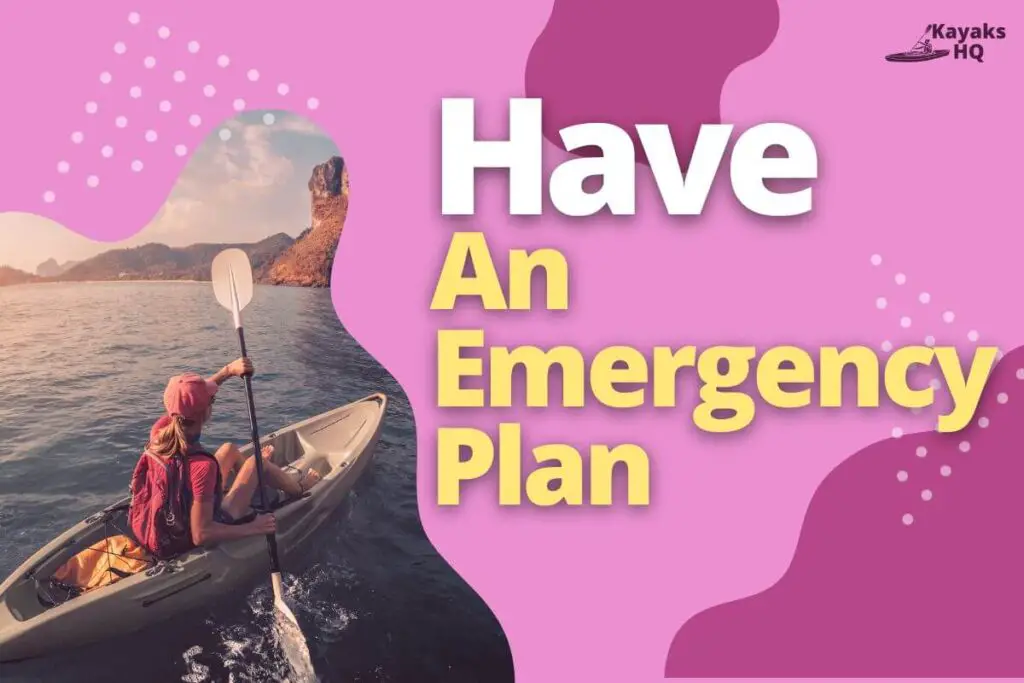
Keep an emergency plan in mind at all times. This might include:
- Knowing where you are going, how long it will take you to get there, and how long it will take to get back.
- Get contact details for someone who can help. If someone is waiting for you at the end of your trip, make sure that they know where to wait and what kind of clothing to wear so that they are prepared if something goes wrong.
- Knowing who to call should something go wrong with your equipment or when on longer trips where help may be hours away from reaching you; this could be a marine rescue service, coastguard or lifeboat crew depending on where exactly you’re kayaking from/to.
Know What Your Stamina Is And Plan Accordingly
A beginner kayaker should know their stamina and plan their trip accordingly. It is important to paddle in calm water and avoid whitewater kayaking until you have the proper skills and accessories.
Paddling with a seasoned paddler is recommended if you are a novice kayaker. Water conditions can change quickly, so it is important to be aware of your surroundings and be prepared for anything.
Whitewater rapids can be dangerous, so it is best to avoid them unless you are an experienced paddler. If you are kayaking in high winds, be sure to stay close to shore and paddle in an efficient way to conserve your energy.
Strainers can be dangerous, so be sure to avoid them.
Stay mobile and keep moving
Being able to move freely and continuously is of paramount importance. If you get stuck, you stand a good chance of getting caught up in the scenery, distracted by wildlife, or resting for too long.
- That’s dangerous because your kayak can be carried away quickly if it’s not going with the flow. So keep paddling! And if this isn’t possible (e.g., when surfing), make sure your paddle is secured so that it can’t float away.
- One must always be on the move and maintain mobility. If you’re in one spot for too long, you could become a target for predators or other dangers.
- Pay attention to the water level and the flow of the water. If you see an obstruction in your path, slow down and be careful. If you’re a beginner, it’s best to stick to calm waters.
Always paddle in the right direction. If you are unsure of what steps to take, it is best to consult an expert or someone with more experience.
Secure All Your Gears Safely To The Kayak
Securing all your gears safely to the kayak is one of the most important tasks you can do before you set off on your adventure.
Put everything in a dry bag, including your phone, food, and water. Make sure that your kayak is in good shape, and if you are bringing any electronics with you, make sure they have their own waterproof cases or bags.
Choosing the right kayak for you is crucial when kayaking alone
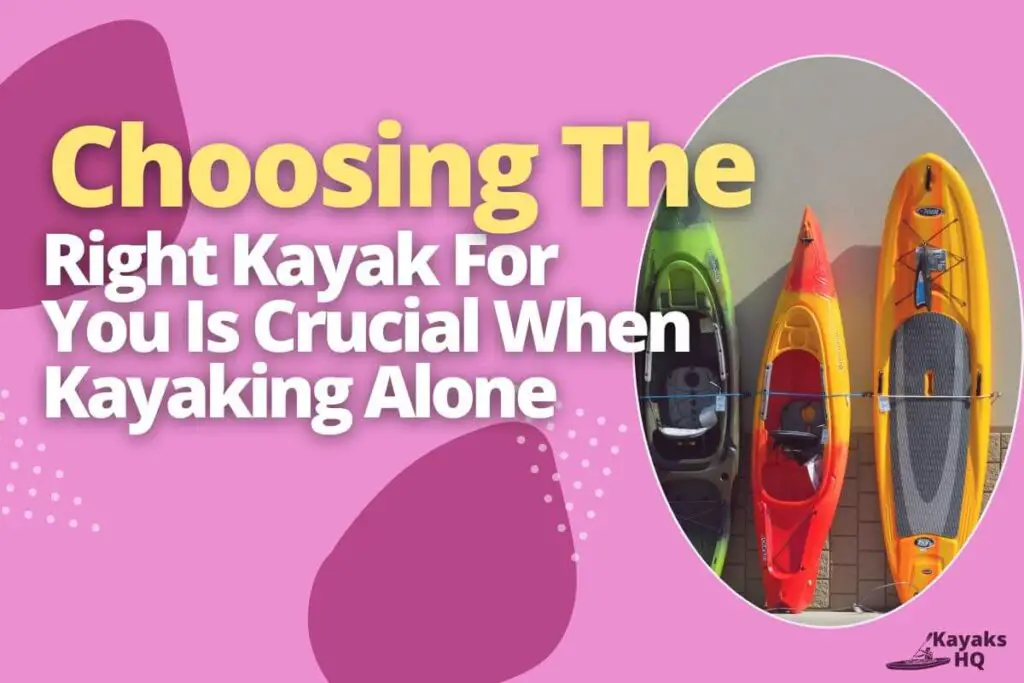
When choosing the right kayak for your solo trips, there are five important factors to consider:
- Stability. Kayak stability is paramount when paddling alone. If you capsize, it’s easy to get into trouble if your kayak isn’t stable enough and doesn’t have enough flotation to prevent you from sinking. Look for a kayak that has wide hulls and plenty of flotation, so it will float right side up even if you flip over.
- Maneuverability. You’ll need to have confidence that your boat will respond well in any situation or body of water, so look for one that’s easy to turn without much effort on your part (like an inflatable). It should also be compact enough not only for loading but also for storage after each trip—you don’t want a large bulky boat taking up all the space in your garage!
- Comfort and usability features such as seat cushions, backrests and thigh pads can help make long paddles feel more bearable because they provide support throughout those hours spent on the water! Just remember, though – comfort comes at a price point too high? No problem! You just gotta know what features matter most before making any final decisions about which ones are worth spending extra money on versus those things you could live without altogether!”
What Kind Of Gear Do You Need To Go Kayaking Alone?
When you’re kayaking alone, there are a few pieces of essential gear that you should take with you. These include:
- Waterproof bag for all your belongings: This is the most basic thing to have when going on any kind of adventure. A good quality waterproof bag will help keep your stuff dry if it starts to rain or gets wet from other reasons (such as falling overboard). The ones we recommend are offered by AmazonBasics and SealLine.
- First aid kit: It’s important to be prepared for any emergency situations that might arise while out in nature. So make sure to pack some first aid essentials with you at all times! We like this one from Adventure Medical Kits because it comes with everything one would possibly need during an emergency situation – including bandages, antibiotics, alcohol wipes, gauze pads, etc.
How Can You Stay Safe While Kayaking Alone?
Before you go out solo on the water, here are some things to consider:
1. Dress appropriately. Always wear a personal flotation device (PFD). If you don’t have one, make sure you carry it with you.
2. Your PFD must fit properly around your neck and chest. Check for any pockets or straps that could come undone.
3. Wear a life jacket while afloat.
4. Have reliable self-recovery skills. Learn how to launch yourself into the kayak when you get thrown into the water.
5. Practice turning the kayak upright if it topples over.
6. Be aware of your surroundings. Pay attention to your direction and navigation.
7. Carry a compass and map.
8. Bring along extra food, drink, and an emergency medicine box.
9. Take your time. Don’t rush. Enjoy every moment.
10. Be safe.
How Can You Prepare For Your Kayaking Trip Alone?
Kayaking is a great way to explore the outdoors, but it’s important to be prepared before heading out on your own. You can use these pointers to organize and get ready for your first solo kayaking adventure:
- Choose a good kayak: It’s important to choose a kayak that is appropriate for your skill level and the conditions you’ll be paddling in. If you’re a beginner, it’s a good idea to choose a kayak with a wider hull for stability.
- Get the right gear: In addition to a kayak, you’ll need a paddle, life jacket, and bilge pump. If you’re paddling in cold water, you may also need a wet suit.
- Know your route: Before heading out, be sure to map out your route and familiarize yourself with the area you’ll be paddling in. It’s also smart to tell someone your itinerary in case of an unexpected event.
- Practice your skills: If this is your first time kayaking, it’s best to get some practice done first in a protected place. When you have this information, you can face any crisis with greater assurance and composure.
- Be prepared for emergencies: Be sure to bring a first-aid kit and a cell phone in case of an emergency. Preparing for the possibility of being trapped or capsized is also important.
If you follow these guidelines, you’ll be well on your way to having a fun and safe time kayaking by yourself.
Kayaking Alone – Is It Safe?
While it is possible to kayak alone, it is important to be aware of the risks and take steps to mitigate them.
There are risks involved while kayaking alone, just like with any other outdoor sport.
However, if you plan ahead and take precautions and safety measures, you can minimize risk.
When Kayaking Alone, What to Do If Something Goes Wrong
If something does go wrong, you will want to do everything within your power to prevent panic. Stay as calm as possible and use the following steps:
- Call for help. Ideally, this is done by another boater who can help out. If there is no other boater around and you have a phone in a waterproof case on board with service, call 911 and ask them to send someone right away. If it’s an emergency situation and there are no other boats around (or if they won’t hear), then try shouting “Help!” over the water at regular intervals in hopes that someone might hear you from shore or another boat nearby may be able to assist in some way.
- Try staying afloat until help arrives by either paddling toward shore or keeping yourself upright using something like a paddle float, a device that attaches to one end of your paddle shaft so that if you fall into the water while kayaking alone, it will keep your head above water for additional time until someone comes along or until help arrives.
Things To Carry When Solo Kayaking
If you plan to kayak solo, it’s important to know what you need to bring along to keep yourself safe while out there. There are many things that could happen to you during a solo kayak trip.
You might run into trouble, get lost, become disoriented, encounter wildlife, or even fall off your boat. If you don’t pack accordingly, you increase your chances of getting hurt or stranded somewhere.
The following list includes everything you’ll want to take with you when kayaking solo. Don’t forget to include your cell phone, wallet, map, torch, compass, flashlight, waterproof bag, sunblock, whistle, bug spray, drinking water, food, and anything else you think you might need.
Conclusion
Even if you’re the best kayaker in the world, mishaps are still possible. It is important to know what to do if something goes wrong while kayaking alone so that you can stay safe and get help if necessary.
In this blog post, we discussed the benefits of kayaking alone. Also, we provided tips on how to do it safely and how to stay safe while kayaking alone. Also, we include tips on how to kayak safely and how not to get hurt.
If you are interested in learning how to kayak, or you are looking for some new adventures, then you have come to the right place. Our website has a lot of information about kayaking and is the best place to start.
Thanks for reading this blog post, and be sure to check back for more!

